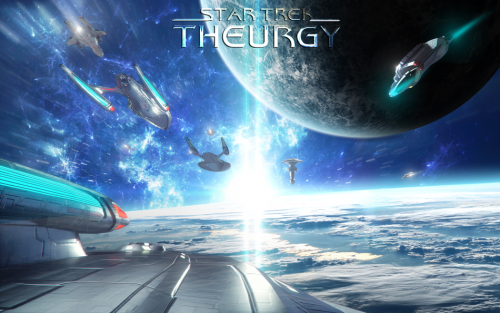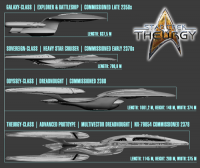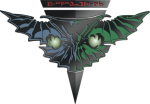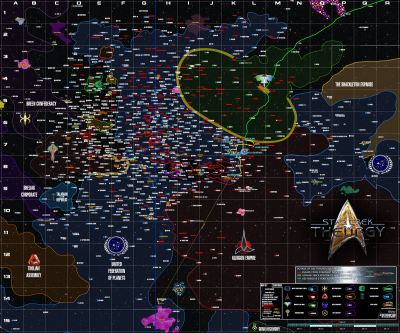Star Trek: Theurgy Canon
From Star Trek: Theurgy Wiki
Quantum reality, or quantum universe, was the term used to describe the alternate timelines in which all possible outcomes for any event take place. Each quantum reality was its own separate parallel universe characterized by a unique quantum signature that could not be altered. All matter resonated on a quantum level with this signature within the universes. In the Theurgy reality, as a result of different events and actions, there were differences from the normal state of the universe as of the year 2381.
Comparing it to the reality where the USS Enterprise-E fought the Reman Praetor Schinzon in 2379, these were the differences in the Theurgy universe:
Starfleet Command
The alien neural parasites that infiltrated Starfleet Command in the year 2364 never did so in Star Trek: Theurgy canon (TNG, Episode 1x25 "Conspiracy").
Instead, the enigmatic aliens in the Theurgy timeline did, but at a later time - perhaps as late as 2375. The nature of these other aliens were shrouded in mystery, but they were not so easily detected. They did not appear on tricorder scans, and while the crew of the Theurgy didn't come to a conclusion , the aliens existed in a state of flux. When the parasites were introduced to the hosts, the effects were both physiological and mental. Observations of the only closely studied host, Ensign Sonja Acreth, made it evident that the hosts were granted superior strength and resistance towards neurological trauma - the stun settings of phasers included.
Based on what Ensign Acreth told her interrogators on the USS Theurgy, it was evident that the alien parasites were of chaotic origin, meaning to tear down the structure of all societies - actively trying to dissolve the Federation and all other galactic powers from within. It was not entirely clear why or how, but it seemed it lay in the parasites' nature to return matter to its original state - energy - and to do so on a galactic scale.
Moreover, they did not deem themselves individuals, but a nameless darkness without structure. Structure and direction seemed to be granted by their hosts in order to achieve their ends, making their existence a paradox. One thing was certain, and that was how the parasites thrived in the extremes of the process towards their intent. It was why they meant to spread the Niga virus, which would not only tear down all the Galaxy's societies, but also constitute a form of high-grade narcotic for the parasites and their hosts throughout the galactic outbreak.
Slipstream Drives
After the USS Voyager returned to Federation space in the year 2378, despite many attempts, Starfleet were not able to re-create the quantum slipstream drive that Species 116 showed to the crew of the USS Voyager. For example, the Vesta-class line of starships were still developed, but without quantum slipstream drives. As of March 2381, the Theurgy crew would learn that the Savi had managed to make this technology work, and as of the beginning of Season 2, the Theurgy was fitted with a limited range Quantum Slipstream drive, which was a viable option for 1 hour of flight, and a 36 hour cool-down period. This technology granted our crew 60 LY of travel during that hour, at the great expenditure of Benamite crystals.
Furthermore, in reference to related technology in the Expanded Universe of Trek novels, transphasic torpedoes hadn't seen mass production and were still in early testing stages, just like transphasic shielding or transphasic compression phaser cannons.
Starship Development
After Starfleet Command was overtaken by the aliens in the Theurgy universe, they began to mobilise its fleet earlier. A lot of resources were put into the fleet yards around the Alpha Quadrant, and the Advanced Starship Design Bureau got everything they needed in order to launch new starships at a quicker pace.
For example, the Theurgy Project was finished in 2378, its first prototype ship - the USS Theurgy - launched thee years ahead of schedule. Also, the Odyssey-class line of starships were launched in 2380, with three ships leaving the fleet yards simultaneously. These were the USS Odyssey (NX-74699), under the command of Admiral Janeway, the USS Enterprise-F NCC-1701-F - replacing the Sovreign-class NCC-1701-E, under the command of Captain Picard and the USS Archeron NCC-74700, under the command of Admiral Sankolov.
Starfleet Astronautical Command Division
The formation of Starfleet Astronautical Command was heavily influenced by the successful deployment of Peregrine-class fighters aboard the starships serving as carriers in the fleet, which was deployed in the Dominion War. The Tactical CONN department belonged to this Division, and its officers consisted of fighter pilots with the white-collared uniform.
The year 2375 - after the conclusion of the Dominion War - the AC-205 Mk I Valkyrie line of fighters were launched, followed by the Mk II and Mk III in 2376 and 2378 respectively. Besides the Valkyrie-program, a competitive Interceptor-program was also implemented, resulting in the AC-347 Knight-class Interceptor being commissioned to starbases and planetary outposts throughout the Federation in 2377. This focus on developing fighter-based crafts for Starfleet was also a shift from Starfleet Command, suggesting that the alien usurpers could have been present as early as 2375, or at least some point after that.
The Last Remnant of Section 31 Died With Sloan in DS9
No Section 31 characters are allowed to be made in the sim. Section 31 died with Sloan in DS9, him being a rogue element and a relic from the time where Section 31 created Control in Star Trek: Discovery. Section 31 was not only a betrayal of Starfleet values, it was a destructive and reckless organisation that never really achieves its goals. The Founders' Disease exacerbated the conflict during the Dominion War by turning it into an existential struggle for the Founders rather than just some war that they could pull out of if desired. If genocide had been achieved, would things have really been better if there was no one to negotiate a peace settlement with? If there was no one with the authority to give the order to stand down, then that would have meant decades, if not centuries, of continued conflict. The thing about organisations is that they tend to find work for themselves. As the old proverb puts it, if all you have is a hammer, every problem looks like a nail.
Worse yet, Section 31 was not accountable to anyone. If its not accountable to the Federation government and people, it is illegitimate. Whatever shoddy story they make up about the founding charter (see ST:ENT), they were a criminal organisation. The best comparison for Section 31 was a extremist paramilitary groups, who fought against people they decided were enemies of the state, usually enabled by corrupt Starfleet admirals. The wider implications for the Federation with the existence of Section 31 was even more troublesome, implying that the Federation was not a functioning constitutional democracy, but is actually authoritarian. Section 31 could not have existed in a place with freedom of the press. It would be outed, publicised and discredited. It implied that the Federation did not have a free media. Neither could Section 31 have existed if the government was accountable to the people of the UFP. Anytime a Starfleet officer knowingly assisted Section 31, they were breaking their oath to the Federation and committing a crime.
With Section 31 incompatible with the UFP presented in Star Trek, this renegade relic of an organisation died with Sloan, and our story will only have use of Starfleet Intelligence in the year 2381.
Political Situation
United Federation of Planets
The aftermath of the Dominion and Borg invasions forced the Federation to establish new relations with many of its former adversaries, the Romulans in particular.
In 2379, cooperation took place between the crew of a Federation Starfleet vessel, the USS Enterprise-E., and Romulan forces to defeat the Praetor Shinzon, whose actions would have destroyed both Earth and the Romulan Star Empire. It was hoped that this would mark the beginning of an end to hostility between the Federation and the Romulans, marking the beginnings of détente with a traditional enemy of the Federation.
After the death of Shinzon, the initial approaches between the Federation and the Romulans continued and a new task force led by the USS Titan was dispatched to the Romulan Neutral Zone in order to begin talks with the Romulans. The USS Theurgy was a part of this task force, yet regrettably, the attempt failed, and the consequence was the Romulan Civil War.
A human by the name Nanietta "Nan" Bacco from the Federation Member State of Cestus III was elected Federation President in October of 2379, serving through the sundering of the Romulan Star Empire. It was unknown if the parasitic aliens that had overtaken Starfleet Command had also infiltrated the Federation Council at that point.
Romulan Star Empire
In a failed plot to destroy the Federation, Romulan Praetor Shinzon was defeated at the Battle of the Bassen Rift, leaving Senator Tal’aura to take the reigns as the new Praetor of the Romulan Star Empire, with the support of Fleet Commander Tomalak. Commander Donatra of the Warbird Valdore had openly opposed the new Praetor, and began a rebellion backed by the strength of the Romulan 3rd and 5th Fleets. Additionally, the Reman people openly demanded a continent on Romulus and reparations for hundreds of years of slavery, which was denied them.
A Romulan blockade of Remus was the Praetor’s reply, as well as cutting food and medical supplies to the sister planet. Affairs within Romulan space deteriorated quickly for the Federation; with the continued Reman upheaval and skirmishes with Donatra’s opposition fleet. Open Civil War began in 2380 when Donatra was able to capture and hold a number of key agricultural worlds, establishing the Imperial Romulan State.
Klingon Empire
In 2376, a coup against Chancellor Martok was designed to throw the Klingon Empire into chaos and allow the two Klingons Morjod and Gothmara to become the new rulers of the Klingon people. This coup against Martok was ultimately unsuccessful, and Morjod and Gothmara were killed. Instead, the alliance with the Federation continued to prosper. In 2379 the two worked together in the construction of the Unity One station. The Unity base was an advanced starbase, representing the accomplishments of the alliance. As part of the design, the station's sophisticated sensor array allowed it to detect even cloaked vessels that were many sectors away.
In 2380, as the Romulan Civil War raged in full, Chancellor Martok accepted the Remans as a protectorate of the Klingon Empire, resulting in Klingon vessels entering Romulan space. Through the year, Klingon forces were involved in a number of skirmishes within Romulan space. After continued attacks and the failure of the Remans to successfully settle on the Ehrei'fvil continent of Romulus, the Klingons allowed the Remans to settle on a planet within the Klingon Empire.
Later in 2380, Chancellor Martok attended a conference with the Federation President and the Romulan Praetor regarding the founding of the Imperial Romulan State. Rather than denounce the new government of Commander Donatra, now Empress of the Imperial Romulan State, Martok instead gave his approval to the new state, recognizing its sovereignty.
Cardassian Union
Directly following the Dominion War, the Cardassian Union was devastated - economically, culturally, and infrastructurally. Facing immediate collapse, the occupying forces of the Federation as well as the Klingon and Romulan Empires worked to establish a new government. The decision was made to return provisional and operational management of the Union to a reformed Depata Council. The council itself was restructured to become a representative democracy working under an elected leader - the Castilian.
Working together, these governments toiled for many years to attempt to stabilize the region. The Klingons provided security for the outlying planets under the watchful eye of the Romulans, whereas the Federation initiated a number of aid and cultural exchange programs, including the Andak Project which intended to restore agricultural production to the Union. Eventually, the Romulans withdrew their aid in the region because of the Romulan Civil War.
During the rebuilding of Cardassian society, major political parties rallied for support. The 'Reunion Project', led under Alon Ghemor, was designed to empower citizens disenfranchised with the old systems of politics which had led Cardassia to its current state. Promoting democracy, free speech, and peace, the Reunion Project won the first major post-Dominion election.
In addition, there were those unhappy with their political standing in the quadrant, and with an aim to prevent Federation ideals seeping into Cardassian society, a hard-line conservative nationalist party was formed to ensure Cardassia rebuilt itself to its former glory. Pejoratively created by members of the Cardassian elite, including several Guls and other officers in the Cardassian Guard, this political party was initally called 'The Directorate' but later changed it's name to 'Cardassia First' in 2380 to distance itself from other extreme nationalist groups.
Following a loss in the first elections, some members of the Directorate were further radicalized against the Federation, believing them the cause for their fall from grace. Attempting to use an old secret society designed to place key members of Cardassian familial elites into the upper echelons of government, they endeavored to gather troops and resources, determined to bring Cardassia back to its 'True Way' by any means necessary. The True Way openly opposed the Andak Project and using said resources tried to shut it down. Following this, the True Way formally became a paramilitary group, however the Cardassian Government considered them a terrorist organisation.
By 2378, Castellan Alon Ghemor had sent Elim Garak to be ambassador to the Federation, resulting on Garak's permanent habitation in Paris on Earth. Garak would reflect that this had been a judicious move on Ghemor's part to remove his potentially toxic reputation from the Ghemor government.
Ghemor was assassinated in 2379, when it appeared to some that he was becoming too close to the Federation in his efforts to stabilize Cardassia. The period after the assassination of Ghemor were especially dark for the Union, and were remembered as the worst period since the Dominion War's end in 2375. It seemed like the Union would fall apart, but this did not occur. Ghemor was succeeded by several short-lived administrations before Rakena Garan was elected Castellan.
The Third Republic of Bajor
After rescinding its petition of Federation Membership during the Dominion War under the advice of Benjamin Sisko, the Third Republic of Bajor officially reopened its request in 2376 and became fully inducted on 29 September 2376. With the added resources of the Federation, Bajor underwent a extended period of peace and prosperity.
In 2377, the Vedek Assembly elected a new Kai, Pralon Onala was chosen. Choosing to distance herself from the political interference of her predecessor, Kai Pralon spoke solely to the Bajoran Government on matters of faith.
Dominion
At the end of the Dominion War, the Treaty of Bajor was drawn up between the Dominion and the major powers of the Alpha Quadrant. The Dominion retreated back into the Gamma Quadrant. Within their home territory, news of the major defeat spread, leading to some rebellions on subject worlds. They were quickly subdued by the Jem'Hadar.
In 2374, the Great Link learned of the apparent reappearance of the Progenitor and sent a ship to investigate. However when Odo and the others arrived they found the Progenitor was apparently killed by radiation of a supernova. The Great Link dissolved as its individual members gave into their grief and despair and drifted off into space. This left Odo and Laas running the Dominion. Over the next several years, Odo concentrated on running the Dominion while Laas traveled in search of other Changelings to convince them to return. Due to the structure of the Dominion, in which most never even saw a Founder, the day-to-day affairs were largely unaffected. During this time, Odo kept the Dominion borders closed to keep the political situation stable and focused his work on transforming the Dominion into a more peaceful and democratic society.
As of 2381, the borders to the Dominion remained closed.
Borg
After the transwarp network was destroyed by the USS Voyager in 2378, the Borg was never seen anywhere near the Alpha Quadrant until March of 2381, where a new invasion attempt was made through subspace tunnels emanating in the Azure Nebula. (This event has just begun and is currently unfolding in Episode 05: Courage is Fear).
Regarding Star Trek's Expanded Universe & Recent Shows
In Star Trek: Theurgy, none of the events depicted in Star Trek novels, comics, or games occur. Yet as the above texts may already suggest, some elements from the Expanded Universe may be implemented as befitting the story. Whether or not something is included in the Star Trek: Theurgy reality is decided by the GM.
Lower Decks, being an animated series that have the wrong kind of of tonality in general compared to the other canon shows, should not be considered canon here in this sim. This also to avoid confusion about uniforms and clashes with the timeline, since our story is very close to that of Lower Decks.
Star Trek: Discovery and Picard, however, are to be deemed canon for Star Trek: Theurgy unless there is a direct conflict with the progression of our story, in which such an incident will be dealt with and clarified on a case to case basis.










